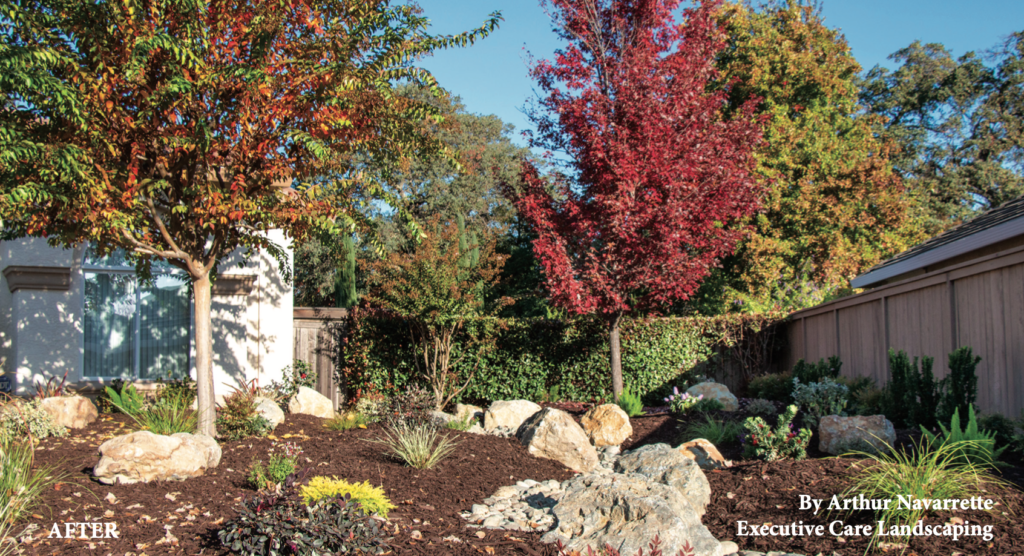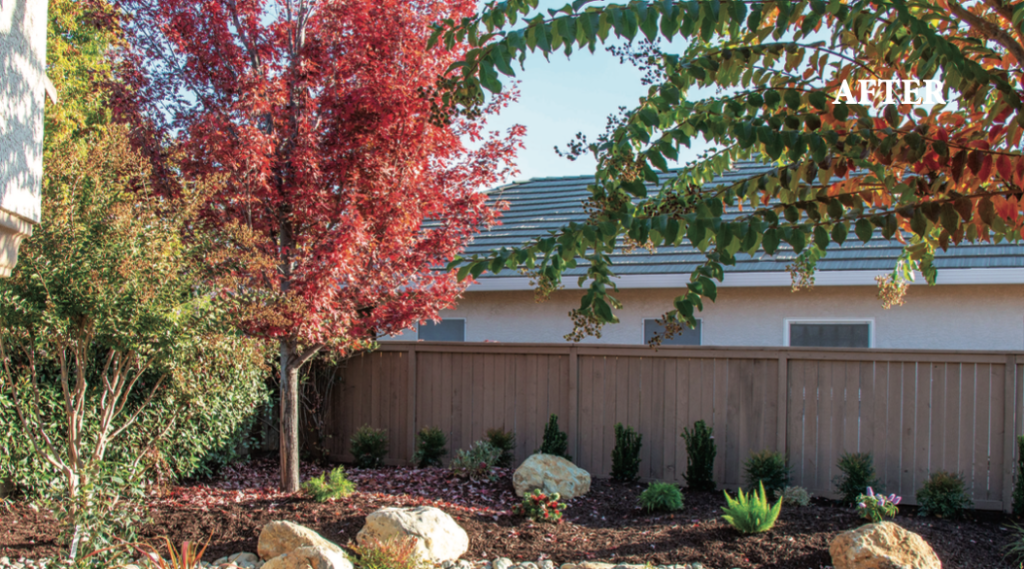
Welcome to our November edition. The year is going quickly, and I hope it is going well for you. I know we are enjoying a good year because of our patient and overall good-natured clients that we have.
– Thank you.

Fall is my favorite time of year. I love seeing the trees change colors and the cooler temperatures are such a wonderful reprieve from the hotter weather. Each year at this time I enjoy doing an article with fall color in view. We are fortunate that we have so many trees in the region that color up with the cold. Therefore, picking a landscape with fall color to talk about is not hard. Let’s first talk briefly about what makes the leaves turn color. The process is fascinating. Several years ago, I wrote a detailed article on this. However, we do not have the space to go into such detail and still discuss the landscape at hand. Therefore, this will be a general overview.
The tree is made up of many chemicals, each having their job to perform. The most important molecule is obviously H2O, or water. Without water nothing exists. Beyond water there are chemicals that are in charge of tissue production, such as the cytokinins and auxins and then the chemicals that are in charge of photosynthesis. Photosynthesis is a complex process of harnessing energy from sunlight and turning it into energy for growth. The chemical compound responsible for this conversion is carbon dioxide, which is a waste product from all breathing creatures. The photosynthesis process uses CO2 (carbon dioxide) in a six-step process that is very detailed. In the beginning steps, CO2 and H2O enter the leaf hitting the pigment of the thylakoid splitting the 02 from the H20. From there, more changes occur but ultimately oxygen is produced along with carbohydrates. This new oxygen is released into the atmosphere, which provides the air we breathe. The carbohydrates (sugars) are used for the plant’s growth.

Now this process holds true all year long except during the fall season. As the weather cools, the tree reacts to the change of temperature and to the longer nights. It starts transferring the H2O (which would freeze if it remained in the leaf) into the roots, leaving the cytokinins, thylakoids, and auxins in the leaf. This higher concentration of chemicals responds to the cooler temperatures by turning color, each variety according to its design. Without H20 diluting the chemicals, the colors are rich and vibrant. The Birch and Poplar trees become a beautiful yellow with their white to slightly grayish bark. The Red Leaf Maples turn a brilliant range of reds, especially in the early morning or afternoon sun, they look like torches. There are also the purple leaves of the Talo and Ash trees to behold. Japanese Maples and Chinese Pistachio trees display a range of colors from oranges to yellows to reds. It’s a beautiful time that unfortunately is over almost as soon as it starts. We have about a month of this beautiful exchange of colors, so please make it a point to enjoy it.
Now for our article. The landscape we are featuring has my favorite tree, Acer Rubrum Autumn Glory one of the Red Leaf Maple varieties. It is a beautiful shade tree that is striking during this season. Our client Nancy, who lives within a Homeowners Association (H.O.A.), endured a two month wait from the time she requested our service to the time we showed up. The H.O.A process frequently adds an additional two to four weeks to any job, dependent upon how often they meet. Nancy owns the biggest lot in the H.O.A. and wanted to remove her lawn completely. She could not envision a plant-only landscape. I shared my vision with her, because I just knew that her yard could be beautiful– even with only plants.
We discussed several things including a dry stream bed, mounding and boulders. There are clients that prefer to forgo a dry stream bed, but the mounds and boulders are design features we use in all our jobs. The most important point I can make with this landscape is that it does not include many of the elements we often use in our normal work. It has no walls, no pavers, no fountain, no flagstone walkways, no patios and no lights. Due to its simplicity, this project qualifies as our basic package, except it is anything but basic! The proper choice and combination of these three elements; mounds, boulders and the correct plants is enough to make any yard beautiful. As promised, this landscape is inviting, colorful, low maintenance, and Nancy loves it! There is no other landscape like hers in her rather large H.O.A., yet it is our “basic package”. I cannot wait for it to mature and really grow into itself.
As we approach the winter months, I always get asked if we continue to landscape. My house payment is due each month, so absolutely! Okay, now for a serious answer. Our winters can be tough on certain varieties, especially considering that they are in plastic containers that offer no insulation. The very act of landscaping, or planting those same cold-sensitive plants from plastic pots into the warmer ground, cares for them best. So landscaping is wise during this season. Once plants are moved into the soil, and mulch is added on top, you have a much more plant-friendly environment. It is still wise to add a frost blanket to protect the foliage of the more sensitive plants, but the overall protection of the plant will be much better (like wearing a warm jacket verses a wind breaker).
Another advantage to planting during this time is that the roots of evergreen plants continue to grow. Plants such as Camellias start to bloom at this time followed by Azaleas (and many other varieties). Finally, gardeners, I highly encourage you to have your cold frames ready. Anytime in November our temperatures can drop. We need to protect our leafy vegetables.
Personal note: I would really appreciate it if you would read my up- coming December article. It is personal and the intent of it is to provide encouragement for life challenges, which is something we all have in common. Happy Thanksgiving. May you be blessed with a grateful heart now and all year long. – Arthur
